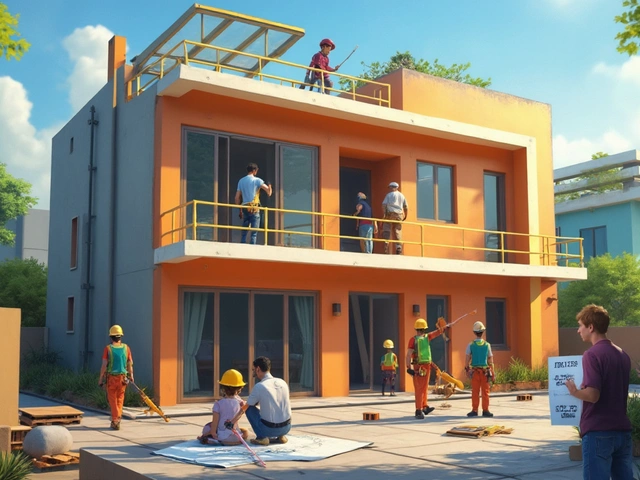Ever heard someone say, “I wish I’d known before I started my loft conversion”? Yeah, me too. You’d think with all the TV renovators and Pinterest boards out there, everyone would waltz through the process with a spreadsheet and a grin. In reality, there's one part of every loft conversion that gobbles up more cash than anything else—yet almost nobody spots it coming. The numbers can make your jaw drop harder than your gran’s best china during a kitchen demolition. Curious which bit that is and why it costs more than a holiday in the Maldives? Pull up a seat—and check your wallet.
The Pricey Centerpiece: Structural Work and Roof Alterations
Want the cold, hard truth? The priciest part of a loft conversion is almost always the structural work—especially if you need big changes to your roof. Let’s break it down. If your house already has a decent roof height and structure, you might avoid major headaches. But if not, you’ll be shoveling cash toward creating the right framework. People often underestimate this, thinking the bricklayer’s beard wax fund or the paint for the new banister will set them back the most. Nope—it’s those steel beams, dormers, joist reinforcements, and sometimes even having to fully alter your roof shape (think mansard or hip-to-gable) that punch biggest holes in your budget.
Look at some real numbers. In the UK, for instance, structural work in a typical dormer conversion eats up around 40% to 50% of the whole budget—according to a detailed 2023 RICS report. If you’re converting a truss loft, the cost can skyrocket. Trussed roofs, common in 1960s–1990s builds, need steel beams installed since there’s just not enough support otherwise. Throw in scaffolding and roofers who don’t flinch at heights, and it’s suddenly a five-figure chunk.
The worst-case scenario? Roof lifts. If your current rafters don’t give you enough head height, you might have to raise the whole roof (yes, literally lifting the top of your house), which quickly doubles or even triples costs. For many, that alone can eat up £35,000 to £50,000 before you’ve even thought about windows or wireless speakers. A few brave souls try to cheat their way around head height minimums; trust me, Building Control catches up—and the fix costs even more.
Another hidden whammy: the need for new flooring joists and reinforcement. Walking across your fancy new attic on original 1930s joists isn’t just creaky, it’s unsafe—and Building Regs won’t sign off unless you beef things up. Structural engineers are worth their weight in gold in these moments. In the table below, spot the breakdown of typical costs for structural work versus other major elements (all 2024 UK averages):
| Loft Conversion Element | Cost (%) | Cost (£, typical 3-bed semi, 2024) |
|---|---|---|
| Structural Work & Roof Alterations | 42 | £21,000 |
| Windows/Skylights | 8 | £4,000 |
| Staircase | 7 | £3,500 |
| Plumbing & Electrics | 9 | £4,500 |
| Insulation & Plastering | 13 | £6,500 |
| Internal Fit-Out | 21 | £10,500 |
See that spike in the first row? That’s where your money takes a parachute jump. And these numbers don’t even include extras like en-suites or built-in storage. Not everyone’s loft needs the full works, but if you’re in a pre-1960s house, or you want a mansard or L-shaped dormer, prepare for structural complexity (and, yeah, dust in places you never imagined).

What Drives Up Structural Costs? Hidden Complications That Sting
You’d think it’s just “make room, add floor, slap on a window,” but the devil is in the hidden details. The costliest surprises lurk inside your old roof: think dodgy rafters, sagging purlins, or horror-show brickwork discovered after you’ve already handed over your deposit. Even if your roof looks fine from the street, an inside survey with a torch often tells a different story. I’ve lost count of friends who planned a simple Velux conversion, then found ancient woodworm had turned their beams into timber laces—cue panic, builder smirk, and another grand gone.
It’s not just the wood. Houses built pre-WW2 might have been constructed to different standards. Builders back then didn’t forsee you wanting to set up an Instagram-worthy home office with a view from your rafters. Modern Building Regs demand you reinforce floor joists to take the weight of people, furniture, and—let’s be honest—a decent home gym. Skimping here is never worth it and can have legal consequences.
Another sneaky budget-eater? Access. Installing a proper staircase isn’t just a question of hammer and nails. You often need to cut into existing floor structures, move pipes or wires, and sometimes sacrifice part of a bedroom or hallway just to fit things in. There’s a reason staircases have a reputation among renovators as both necessary and wallet-emptying.
And good luck if your house is in a conservation area, has a flat roof, or sits near a flight path. Planning officers love terms like “visual amenity” or “street scene harmony”—translation: more reports, surveys, and often higher costs. I remember a neighbor in our street who spent three months and several rounds of paperwork just to get a small dormer approved, thanks to a local restriction.
Weather counts, too. Here in the UK, everyone jokes about four seasons in a day, but for roofers, that’s no laughing matter. Sudden rain during roof work means you need extra protection, more scaffolding, or even delays. Every day the job runs late, you’re burning money—builders’ day rates don’t care about sunshine or storms. Here’s where tipping your crew with good tea pays real dividends.
Notably, don’t forget the scaffolding. It’s not just a bunch of poles—on a two-storey house, proper full wrap-around scaffolds can cost two grand or more. Need lifting equipment? Bigger bill. Also, materials have seen price spikes recently—timber and steel prices rose by up to 24% between 2020 and 2023, due to supply chain crunches and higher demand. Every time I check the latest prices, Lydia gives me that wide-eyed look that says, “Now can we just paint the kitchen instead?”

Practical Tips: How to Keep Structural Costs Under Control
No one wants their dream loft to become a budgetary horror story. Here’s how to pull back some control (and maybe even afford a fancy sofa at the end of it all):
- Get a full structural survey done before you start: Don’t rely on guesswork. Bring in a chartered surveyor or structural engineer to poke around your rafters, check for rot, and spot tricky corners before you’re locked in.
- Pick your builder/designer wisely: Loft conversions are an art and a science. The best teams will highlight potential structural issues before the quote, so there’s less “unexpected” later.
- Consider a modular/pre-fabricated loft: Modular dormers built offsite and craned into position are growing in popularity. It’s quick, sometimes cheaper, and can cut mess to a minimum—especially handy if you work from home, as Lydia did during ours.
- Balance “future proofing” with budget reality: It’s tempting to go all-in, but adding an en-suite or fancy windows later is often easier (and less expensive) than complex roof changes. Invest in the core structure first; you can always jazz up the details later.
- Always get more than one quote: Prices on structural work vary widely. Don’t just go for the cheapest: ask for details about materials, timeframes, and whether they’ve handled your house type before.
- Keep a 10-15% contingency fund: Even the best-laid plans can go sideways. Having a buffer avoids awkward arguments (or worse, unfinished jobs when the cash runs dry).
One more thing: Don’t assume you can skip Building Regs or try to “do it on the cheap” with under-the-table builders. The council can—and will—force you to redo non-compliant work. You’ll pay double and endure months lost. Trust me, spending a bit more on proper design and sign-off saves far more in the long run.
Your choices before the build—like picking a dormer style or deciding if you can live with a lower ceiling—often have the biggest ripple effect on costs. If all you need is an office or snug, consider a simple Velux conversion. But if you’re after a palatial master suite (or two bedrooms and a bathroom), accept that major structural work is in your future—along with a higher price tag.
Loft conversions transform homes, boost property values by up to 20%, and can even change how a family lives day-to-day. But unless you’re blessed with an ideal roof space, the loft conversion cost for structural work will almost always be the dragon you need to slay. If you plan ahead, ask the right questions, and keep an eagle eye on those beams and joists, you won’t be blindsided. And hey, maybe you’ll have something left over for that rooftop smart TV or the world’s comfiest beanbag. I know Lydia’s already measuring up...




Write a comment